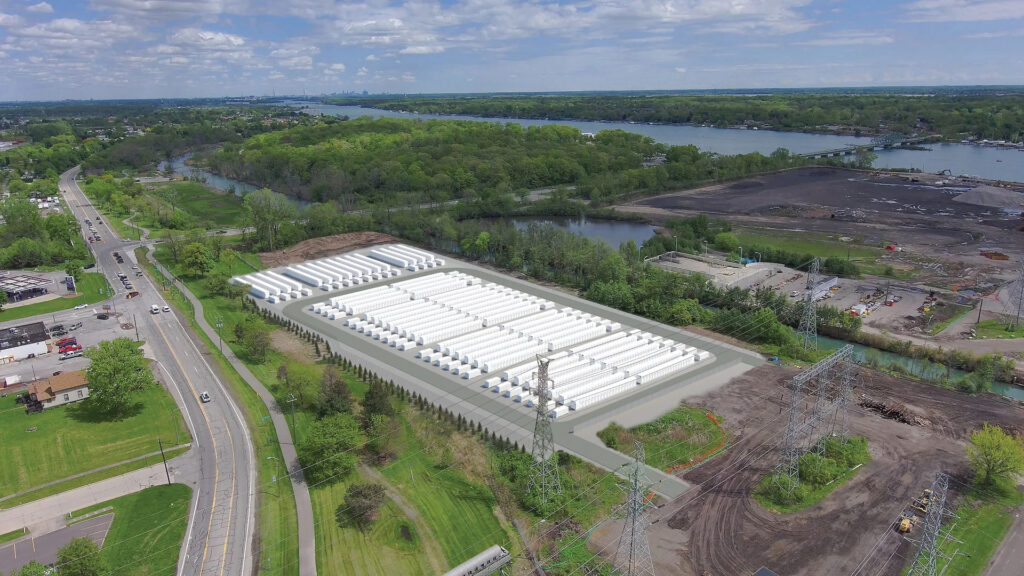The UWUA has witnessed many shifts in the energy sector, but DTE Energy’s recent decision to establish a state-of-the-art battery storage facility at the former Trenton Channel Power Plant site marks a significant milestone. This iconic plant, which operated along the Detroit River since 1924, symbolized local power generation and economic stability until its closure in 2022. DTE Energy broke ground on the battery storage facility in June. Construction will continue through 2025, and the Trenton Channel Energy Center is expected to begin operating in mid-2026.

The $460 million project, partially funded by $140 million in tax incentives from the 2022 federal Inflation Reduction Act, will become the largest battery storage facility in the Great Lakes region and will play a crucial role in storing energy generated from DTE’s expanding wind and solar operations. By capturing energy from the grid during periods of low demand and releasing it when demand peaks, the facility will enhance the reliability and efficiency of Michigan’s energy grid.
Battery storage is expected to soar in the coming years. In 2024 alone, U.S. storage capacity is expected to double compared to 2023, reaching 30 gigawatts if all the planned projects come online. The International Energy Agency (IEA) emphasizes the need for a rapid expansion of battery storage to meet global climate goals, predicting a sixfold increase in capacity by 2030.
The Trenton project makes significant strides in helping Michigan reach its ambitious renewable energy goals — 60% by 2030 and 100% clean energy by 2040. The facility will store 220 megawatts, or 880 megawatt-hours, of energy — enough to power approximately 40,000 homes for a full day or up to 150,000 homes for four hours. “Michigan is the first state in the Midwest to establish an energy storage standard, which is now the third most ambitious in the nation,” Michigan Gov. Gretchen Whitmer told those assembled at the June groundbreaking. “DTE’s new center here in Trenton will help us meet 10% of the statewide storage goal all by itself.”
By choosing to locate the facility at the site of a former fossil fuel power plant, DTE is capitalizing on existing infrastructure, as these sites already have necessary connections to the energy grid. Moreover, since battery storage systems require significantly less space than power plants, the conversion process is relatively streamlined. The company is assessing all of its interconnection assets — including former power plants and large substations — as potential sites for battery storage.
Jim Harrison, UWUA’s Director of Renewable Energy, has a personal connection to the Trenton plant; it’s where his father and grandfather worked and where he began his career in 1978. For Harrison, the plant’s transformation into a green energy hub is surprising. “After the 2022 closure, I never imagined this type of new life for Trenton.” He acknowledges the innovative use of the existing infrastructure and sees potential for this model to be replicated at other sites, particularly as battery storage technology improves. However, Harrison cautions that battery storage won’t necessarily bring large numbers of jobs, as these types of systems are often remotely operated or managed by a few on-site employees.
Recognizing these challenges, Local 223 President Juanita Ray is working to ensure that any jobs created at the Trenton Channel Energy Center will be union positions. “Seeing the construction of this battery plant is bittersweet for me. I started my own career in a power plant, and it was members like those at Trenton that helped power our country’s growth. We’re doing everything we can to ensure a just transition for both the Trenton workers and their community,” Ray said. Local 223 is currently in discussions with DTE to figure out not only the types of jobs that will ultimately staff the plant but a timeframe for getting them into the union.
Outside of jobs, the Trenton project promises substantial economic benefits for the local community, where many Local 223 members live. The tax revenue generated from the project is expected to surpass that of the former coal plant, providing vital funds for schools and public services in the Trenton/Wayne County area.
As the Trenton Channel Energy Center project progresses, the UWUA will continue to work to ensure that the benefits of this transformation are shared equitably among workers and the community.

